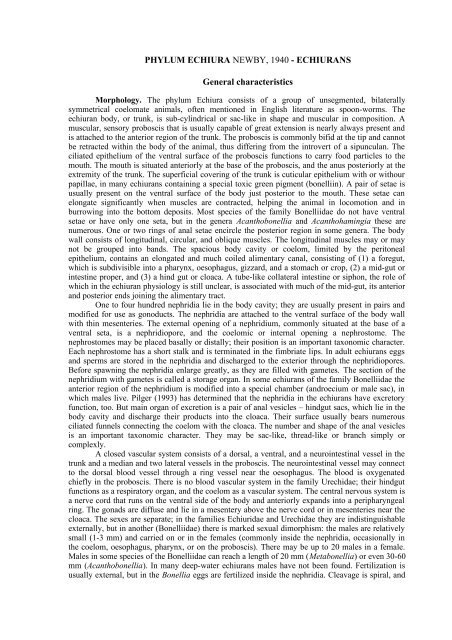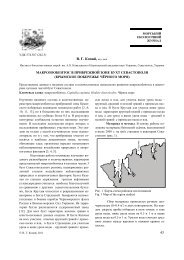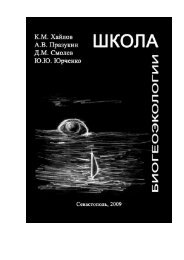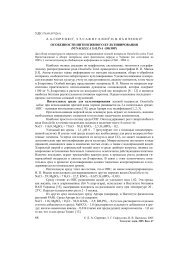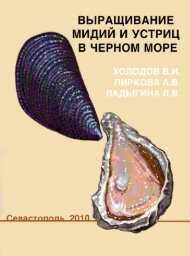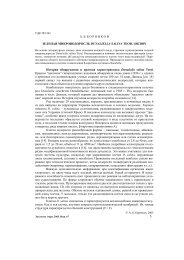PHYLUM ECHIURA NEWBY, 1940 - ECHIURANS ... - IBSS Repository
PHYLUM ECHIURA NEWBY, 1940 - ECHIURANS ... - IBSS Repository
PHYLUM ECHIURA NEWBY, 1940 - ECHIURANS ... - IBSS Repository
You also want an ePaper? Increase the reach of your titles
YUMPU automatically turns print PDFs into web optimized ePapers that Google loves.
<strong>PHYLUM</strong> <strong>ECHIURA</strong> <strong>NEWBY</strong>, <strong>1940</strong> - <strong>ECHIURA</strong>NS<br />
General characteristics<br />
Morphology. The phylum Echiura consists of a group of unsegmented, bilaterally<br />
symmetrical coelomate animals, often mentioned in English literature as spoon-worms. The<br />
echiuran body, or trunk, is sub-cylindrical or sac-like in shape and muscular in composition. A<br />
muscular, sensory proboscis that is usually capable of great extension is nearly always present and<br />
is attached to the anterior region of the trunk. The proboscis is commonly bifid at the tip and cannot<br />
be retracted within the body of the animal, thus differing from the introvert of a sipunculan. The<br />
ciliated epithelium of the ventral surface of the proboscis functions to carry food particles to the<br />
mouth. The mouth is situated anteriorly at the base of the proboscis, and the anus posteriorly at the<br />
extremity of the trunk. The superficial covering of the trunk is cuticular epithelium with or withour<br />
papillae, in many echiurans containing a special toxic green pigment (bonelliin). A pair of setae is<br />
usually present on the ventral surface of the body just posterior to the mouth. These setae can<br />
elongate significantly when muscles are contracted, helping the animal in locomotion and in<br />
burrowing into the bottom deposits. Most species of the family Bonelliidae do not have ventral<br />
setae or have only one seta, but in the genera Acanthobonellia and Acanthohamingia these are<br />
numerous. One or two rings of anal setae encircle the posterior region in some genera. The body<br />
wall consists of longitudinal, circular, and oblique muscles. The longitudinal muscles may or may<br />
not be grouped into bands. The spacious body cavity or coelom, limited by the peritoneal<br />
epithelium, contains an elongated and much coiled alimentary canal, consisting of (1) a foregut,<br />
which is subdivisible into a pharynx, oesophagus, gizzard, and a stomach or crop, (2) a mid-gut or<br />
intestine proper, and (3) a hind gut or cloaca. A tube-like collateral intestine or siphon, the role of<br />
which in the echiuran physiology is still unclear, is associated with much of the mid-gut, its anterior<br />
and posterior ends joining the alimentary tract.<br />
One to four hundred nephridia lie in the body cavity; they are usually present in pairs and<br />
modified for use as gonoducts. The nephridia are attached to the ventral surface of the body wall<br />
with thin mesenteries. The external opening of a nephridium, commonly situated at the base of a<br />
ventral seta, is a nephridiopore, and the coelomic or internal opening a nephrostome. The<br />
nephrostomes may be placed basally or distally; their position is an important taxonomic character.<br />
Each nephrostome has a short stalk and is terminated in the fimbriate lips. In adult echiurans eggs<br />
and sperms are stored in the nephridia and discharged to the exterior through the nephridiopores.<br />
Before spawning the nephridia enlarge greatly, as they are filled with gametes. The section of the<br />
nephridium with gametes is called a storage organ. In some echiurans of the family Bonelliidae the<br />
anterior region of the nephridium is modified into a special chamber (androecium or male sac), in<br />
which males live. Pilger (1993) has determined that the nephridia in the echiurans have excretory<br />
function, too. But main organ of excretion is a pair of anal vesicles – hindgut sacs, which lie in the<br />
body cavity and discharge their products into the cloaca. Their surface usually bears numerous<br />
ciliated funnels connecting the coelom with the cloaca. The number and shape of the anal vesicles<br />
is an important taxonomic character. They may be sac-like, thread-like or branch simply or<br />
complexly.<br />
A closed vascular system consists of a dorsal, a ventral, and a neurointestinal vessel in the<br />
trunk and a median and two lateral vessels in the proboscis. The neurointestinal vessel may connect<br />
to the dorsal blood vessel through a ring vessel near the oesophagus. The blood is oxygenated<br />
chiefly in the proboscis. There is no blood vascular system in the family Urechidae; their hindgut<br />
functions as a respiratory organ, and the coelom as a vascular system. The central nervous system is<br />
a nerve cord that runs on the ventral side of the body and anteriorly expands into a peripharyngeal<br />
ring. The gonads are diffuse and lie in a mesentery above the nerve cord or in mesenteries near the<br />
cloaca. The sexes are separate; in the families Echiuridae and Urechidae they are indistinguishable<br />
externally, but in another (Bonelliidae) there is marked sexual dimorphism: the males are relatively<br />
small (1-3 mm) and carried on or in the females (commonly inside the nephridia, occasionally in<br />
the coelom, oesophagus, pharynx, or on the proboscis). There may be up to 20 males in a female.<br />
Males in some species of the Bonelliidae can reach a length of 20 mm (Metabonellia) or even 30-60<br />
mm (Acanthobonellia). In many deep-water echiurans males have not been found. Fertilization is<br />
usually external, but in the Bonellia eggs are fertilized inside the nephridia. Cleavage is spiral, and
the larva is a trochophore. The metamorphosis and settlement of the echiuran larvae have been<br />
thoroughly studied by many scientists (Hatschek, 1880; Baltzer, 1928; Newby, <strong>1940</strong>; 1946). It was<br />
shown for the larval development in the family Bonelliidae (using Bonellia viridis as an example)<br />
that sex is genetically determined only in very small number of larvae, while others metamorphose<br />
into females after settling on the bottom, and males after settling on a female’s body (Jaccarini et<br />
al., 1983).<br />
Systematic position. Zoologists in the middle of the 19th century considered that the<br />
echiurans together with sipunculans and priapulids constituted a special group of animals which<br />
Quatrefages (1847) called the Gephyrea (from γεφυρα (Greek), a bridge). They had the impression<br />
that these groups of animals formed a link between the annelids and the echinoderms. Sedgwick<br />
(1898) raised the Sipunculoidea and Priapuloidea to the rank of phyla, but continued to consider the<br />
Echiuroidea as a class of the Annelida. The Echiuroidea was established as a phylum largely as a<br />
result of the studies of Newby (<strong>1940</strong>), who showed that annelids and echiurans differ considerably<br />
in their mode of development, that the mesodermal bands of developing echiurans show no trace of<br />
segmentation. The phyletic status of the group is now generally accepted (Zoological Records,<br />
Vermes Section; Fisher, 1946; Stephen & Edmonds, 1972; Meglitsch & Schram, 1991; Rouse &<br />
Fauchald, 1995, etc.). Zenkevich (<strong>1940</strong>) had an opinion, which was later supported by Ax (2000)<br />
that echiurans definitely are annelids, and the absence of segmentation in adult forms is just a<br />
secondary feature. This point of view was recently confirmed by evidence that echiuran larvae have<br />
metamerically disposed units of nervous system which may correspond with annelid’s segments,<br />
witnessing that echiurans originate from segmented animals (Hessling & Westheide 1999;<br />
Hessling, 2002, 2003). Molecular analysis also indicates that echiurans are related to annelids, and<br />
some scientists consider them as a separate group within the phylum Annelida (Staton, 2003), while<br />
others believe that they are close to the polychaetes of the family Capitellidae (Bleidorn et al.,<br />
2003; Hall et al., 2004) or Trichobranchidae (Colgan et al., 2006).<br />
Ecology. All echiurans are marine, except for a few species that occur in brackish water.<br />
Their bathymetric range is extensive, from the intertidal zone to a depth of ten thousand meters.<br />
They are soft-bodied, almost defenseless creatures that live in burrows. Some echiurans prefer<br />
burrows which are already dug, others dig them themselves; there are species that make U-shaped<br />
burrows, having two openings. These burrows in sand or mud often attract many commensals:<br />
crustaceans, polychaetes, mollusks, sipunculans, etc. (Anker et al., 2005). In most echiurans<br />
locomotion is much restricted, but there are forms which can crawl out of their burrows and move<br />
by peristaltic contractions of the muscles. Some members of the family Bonelliidae use their<br />
proboscis for locomotion.<br />
Most echiurans are typical deposit-feeders. The spoon-like proboscis aids the species of the<br />
family Bonelliidae to direct sand, mud, detritus, etc. from their surroundings into their mouths and<br />
extract organic matter from the ingested material. The deep-water echiuran Kurchatovus<br />
tridentatus, found in sunken pieces of wood, roots of sea grasses, and shells of cocoa-nuts, is likely<br />
to be a xylophage, and members of the genus Urechis (family Urechidae) feed on seston. They<br />
secrete a slime net from the glands at the base of the proboscis and pump water together with<br />
suspended particles through this net by peristalsis. Intermittently, the net becomes clogged with<br />
trapped food, is consumed, and a new net is constructed.<br />
Echiurans have definite practical value: they serve as food for rays and flatfish off the coast<br />
of Chile (Gay, 1854), and for pinnipeds in the Russian Far East seas (Zaks, 1933). Some species are<br />
used as bait: Urechis unicinctus in Japan and Korea (Fisher, 1952), and Echiurus echiurus in<br />
Belgium (Skorikov, 1909). Koreans also catch U. unicinctus with iron hooks, dry them and eat<br />
(Sato, 1939).<br />
Collection, fixation, and identification<br />
Echiurans must be treated with care on collection, because their proboscis is deciduous and<br />
usually breaks off entirely or partially. Bottom samples quite often contain only echiuran proboscis,<br />
which is absolutely insufficient for normal identification. Live animals must be narcotized by<br />
placing them in a 7% solution of magnesium chloride or by placing them in cool sea water to which<br />
is added very carefully a small quantity of ethyl alcohol or some crystals of menthol. It is highly<br />
desirable to relax or narcotize a specimen before it is fixed and to leave it in the relaxing agent for
up to 24 hours in order to prevent it from becoming contracted and its internals from becoming<br />
distorted when it is directly plunged into fixatives. Echiurans should be fixed in a 4% solution of<br />
formalin in sea water, but later animals have to be placed in 70% alcohol for storage. It is better to<br />
take 6-8% formalin for the fixation of large echiurans, otherwise some of their internals may<br />
become macerated.<br />
In order to identify an echiuran it is nearly always necessary to dissect and examine its<br />
internal morphology. The animal is placed with its ventral side down in a dish, and the dissection is<br />
performed by carefully cutting the body wall longitudinally along the mid-dorsal line of the trunk<br />
with surgical scissors. If there are any signs of maceration, especially of the thin tissues of the mudfilled<br />
intestine, it is often possible to wash away some of the macerated material by directing on to<br />
it a fine stream of water from a pipette. The nephridia of the specimens belonging to the family<br />
Bonelliidae may contain dwarf males, morphological features of which (presence or absence of<br />
ventral setae) are sometimes used in systematics.<br />
Main references: Fisher, 1946; Stephen & Edmonds, 1972; Murina, 1984, 1993; Pergament,<br />
1961; Nishikawa, 2002.<br />
Systematic part<br />
About 160 species of the Echiura are described to date. Most of them belong to the families<br />
Echiuridae (more than 80 species) and Bonellidae (about 70 species) (Murina, 1993). The family<br />
Urechidae consists of only 4 species. The present paper accepts a term ‘echiuran’ or ‘spoon-worm’<br />
in reference to an animal belonging to the phylum and a term ‘echiurid’ in reference to the member<br />
of the family Echiuridae, as was proposed by Stephen and Edmonds (1972).<br />
The same authors (1972) divided the phylum Echiura into three orders (Echiuroinea,<br />
Xenopneusta, and Heteromyota) and four families (Echiuridae, Bonelliidae, Urechidae, and<br />
Ikedaidae). Some authors (DattaGupta, 1976; Saiz-Salinas, 1987) separated the family<br />
Thalassematidae from the family Echiuridae. Stephen and Edmonds regard it as a subfamily, which<br />
is accepted in the present paper. Nishikawa (2002) has recently studied the internal morphology of<br />
Ikeda taneioides, cancelled the family Ikedidae and the order Heteromyota. The present phylum<br />
Echiura includes two orders and three families.<br />
KEY TO THE ORDERS OF THE <strong>PHYLUM</strong> <strong>ECHIURA</strong><br />
1 (2). Posterior region of intestine enlarged and acts as respiratory organ; cloaca functions as pump.<br />
Proboscis short, reduced to slightly pointed conical lobe, never breaking off during fixation.<br />
Ventral and anal setae present ……………………………………. Xenopneusta<br />
2 (1). Posterior region of intestine not enlarged and does not act as respiratory organ; cloaca not<br />
modified. Proboscis normally developed, may break off during fixation. Ventral and anal<br />
setae present or absent ………………………………………….. Echiuroinea<br />
Order Echiuroinea Bock, 1942<br />
Proboscis usually normally developed, bifid or not bifid at tip. Blood vascular system<br />
present. Posterior region of intestine not enlarged, does not act as respiratory organ; cloaca not<br />
modified, but may be expanded. Nephridia paired or unpaired, varying in number. Ventral and anal<br />
setae present or absent.<br />
KEY TO THE FAMILIES OF THE ORDER ECHIUROINEA<br />
1 (2). Species with marked sexual dimorphism. Females with bifid proboscis, occasionally with<br />
simple proboscis. Nephridia commonly unpaired (species from Sea of Japan with one<br />
nephridium). Anal setae absent; ventral setae present or absent (species from Sea of Japan<br />
without ventral setae). Anal vesicles usually branched …………. Bonellidae (p. )<br />
2 (1). Species without sexual dimorphism. Proboscis not bifid. Nephridia paired, or unpaired and<br />
numerous (genus Ikeda). One pair of ventral setae present; anal setae absent or form two<br />
rings. Anal vesicles sac-like and not branched ……………….. Echiuridae (p. )
Family Bonelliidae Lacaze-Duthiers, 1858<br />
Echiurans with marked sexual dimorphism. Males small, 1–3 mm, occasionally to 60 mm<br />
long, without proboscis, with substantially reduced internal organs, sometimes with ventral setae;<br />
usually found in female nephridium. Females with long bifid proboscis (in some species proboscis<br />
not bifid). Ventral setae usually either two or absent, occasionally one or numerous. Anal setae<br />
absent. Muscles not grouped into bands. Usually one or two, sometimes three nephridia present.<br />
Anal vesicles usually branched, or not branched, thread-like (genera Zenkevitchiola,<br />
Choanostomellia, Pseudoikedella). Neurointestinal and dorsal blood vessels usually connected<br />
through blood capillaries or lacunae of intestine.<br />
The Key includes four genera; three genera and three species have been recorded in the<br />
Russian waters of the Sea of Japan.<br />
KEY TO THE GENERA OF THE FAMILY BONELLIIDAE<br />
1 (2). Anal vesicles falciform with short tree-like branches. Proboscis somewhat bifid at tip<br />
………………..……………………………..………………….Nellobia<br />
2 (1). Anal vesicles branched. Proboscis markedly bifid.<br />
3 (6). Nephrostome located distally. Anterior part of nephridium not modified into androecium.<br />
4 (5). Nephrostome placed on long stalk; nephridium not reaching posterior end of body. Proboscis<br />
shorter than body. Males small ……………………………………….Eubonellia<br />
5 (4). Nephrostome placed on short stalk; nephridium long, almost reaching posterior end of body.<br />
Proboscis longer than body ……………………….……………….Ikedella<br />
6 (3). Nephrostome located almost basally. Anterior part of nephridium not modified into<br />
androecium. Males relatively large. (20–35 mm long) ……………..Achaetobonellia<br />
Family Echiuridae Quetrefages, 1847<br />
Echiurans without sexual dimorphism. Proboscis usually well-developed, but never bifid.<br />
Pair of ventral setae present in all genera, while anal setae present only in Echiurus. Longitudinal<br />
muscles continous, in some genera of subfamily Thalassematinae forms longitudinal muscle bands.<br />
Nephridia usually paired; one to seven pairs (sometimes to 10-32 pairs) present; more rarely<br />
nephridia unpaired and very numerous, to 200-400 (genus Ikeda). Anal vesicles usually elongate or<br />
swollen sacs and not branched. Dorsal and neurointestinal blood vessels usually connected through<br />
ring vessel in posterior region of foregut.<br />
Remarks. Nishikawa (1998) showed that Ikeda taneioides has typical for the echiurids<br />
disposition of muscle bands in the body wall, which became sufficient grounds to consider the<br />
family Ikedidae (=Ikediidae) to be a junior synonym of the Echiuridae.<br />
KEY TO THE SUBFAMILIES OF THE FAMILY ECHIURIDAE<br />
1(2). Two rings of setae surround posterior (anal) region of body. Post-pharingeal diaphragm,<br />
incompletely separates body cavity into two parts. Nephrostome without spirally coiled lips<br />
……………………………………………………………..Echiurinae<br />
2(1). No rings of setae surround posterior (anal) region of body. Post-pharingeal diaphragm absent.<br />
Nephrostome may or may not possess spirally coiled lips .……… Thalassematinae<br />
Subfamily Thalassematinae Forbes et Goodsir, 1841<br />
Anal setae absent. Longitudinal layers of muscles continuous or grouped in bands. Postpharyngeal<br />
diaphragm absent. Nephrostome lips may or may not be spirally coiled.
The subfamily includes eight genera. In the Russian waters of the Sea of Japan one member<br />
of one genera has been found and one more genus may be found.<br />
KEY TO THE GENERA OF THE SUBFAMILY THALASSEMATINAE<br />
1(2). Nephrostomal lips large, pronounced, expanded into leaf-shaped structure; anterior extremity<br />
of proboscis expanded or fan-shaped…………………………………Arhynchite.<br />
2(1). Nephrostomal lips small, poorly developed, not expanded into leaf-shaped structure; anterior<br />
extremity of proboscis rounded and not expanded or fan-shaped………….…………….<br />
……………………………………………………………………………Thalassema.<br />
REFERENCES<br />
Anker, A., Murina G.-V., Lira C., Caripe J.A.V., Palmer A.R., & Jeng M.-S. 2005. Macrofauna<br />
associated with echiuran burrows: a review with new observation of the innkeeper worms,<br />
Ochetostoma erythrogrammon Leuckart and Rüppel , in Venezuela // Zool. Stud. V. 44 (2).<br />
P. 157-190.<br />
Biseswar, R. 1997. Discovery of the deep-see echiuran in the North East tropical Atlantic, with<br />
redescription of the species // Zoosystema. V. 19 (2-3). P. 219-222.<br />
DattaGupta, A. K. 1983. Echiurans collected during the SAFARI I Cruise in the Indian Ocean,<br />
south of Madagascar // Bull. Mus. Hist. Nat. Paris, 4e ser. 5, section A, N 4. P. 1045-1050<br />
DattaGupta, A K. 1985. Echiura, a significant component of benthic community // Peuplements<br />
profonds du golfe de Gasconge. Echiuriens. 25. P. 375-378.<br />
DattaGupta, A K. & Singal, R. 1978. Morphology of Achaetobonellia maculata Fisher (Echiura) //<br />
Zool. Anz. Bd. 1/2. S.136-142<br />
Hessling, R. 2003. Novel aspects of the nervous system of Bonellia viridis (Echiura) revealed by the<br />
combination of immunohistochemistry, confocal laser - scanning microscopy and three –<br />
dimensional reconstruction // Hydrobiology. V. 494. P. 225-239.<br />
Fisher, W.K. 1946. Echiuroid worms of the North Pacific Ocean // Proc. U. S. Nat. Mus. V. 96. P.<br />
215-292<br />
Gay, C. 1854. Historia fisica y politica de Chile. Zoologia. V. 8, Suppl. 475 p.<br />
Gideon, P. W., Menon, K. B., Rao, S. R., & Jose, K. V. 1956. Occurrence of the echioroid worm Ikedella<br />
misakiensis (Ikeda) in Indian water (Gulf of Kutch) //J. Bombay Nat. Hist. Soc. V. 54. P. 201-202.<br />
Ikeda, J. 1904. The Gephyrea of Japan // J. Coll. Univ. Tokyo, Japan. V. 20, Art 4. P. 1-87.<br />
Klimova, V.L. 1984. Macrozoobenthos of the Far Eastern State Marine Reserve // Zhivotny Mir<br />
Dalnevostochnogo Morskogo Zapovednika. Vladivostok: DVNTs AN SSSR. P. 4-29. (In<br />
Russian).<br />
Li Fenglu, Wang Wei, & Zhou Hang. 1994. Studies on the echiurans (Echiura) of the Yellow Sea<br />
(Huanghai) and Bohai Sea // J. Ocean Univ. Qingdao. V. 24, N. 2. P.104-210 (In Cinense).<br />
Makarov, V.V. 1950. On the fauna of Sipunculida, Echiuridae, and Priapulidae of the Russian Far<br />
East seas // Issledovaniya Dalnevostochnykh Morei SSSR. Issue 2. P. 239-247. (In<br />
Russian).<br />
Murina, V.V. 1993. New data on the fauna of Sipunculida, Echiurida, Priapulida of the Atlantic<br />
Ocean // Trudy Instituta Okeanologii AN SSSR. V. 127. P. 107-120. (In Russian).<br />
Nishikawa, T. 2001. New localities of the echiran, Arhynchite arhynchite (Ikeda) and the<br />
enteropneusts, Ptychodera flava Eschscholtz in the Japanese waters, revealed by a survey of<br />
specimens kept in University Museum, University of Tokyo // The Nanki Seibutu. V. 43. P.<br />
137-138. (In Japanese)<br />
Nishikawa, T. 2002.Comments on the taxonomic status of Ikeda taenoioides (Ikeda, 1904) with<br />
amendments in the classification of the phylum Echiura // Zool. Sci. V. 19. P. 1175-1180.<br />
Pergament, T.S. 1961. On the fauna of Echiurida of the USSR Far East seas // Issledovaniya<br />
Dalnevostochnykh Morei SSSR. Issue 7. P. 144-150. (In Russian).
Pilger, J.F. 1993. Echiura // Microscopic Anatomy of Invertebrates. V. 12: Onychophora,<br />
Chilopoda, and Lesser Protostomata. Wiley-Liss, Inc. P. 185-236.<br />
Pilger, J.F. //// Echiura // Taxonomic atlas of the benthic fauna of the Santa Maria Basin and<br />
western Santa Barbara Channel. V. ///. Santa Barbara Museum of Natural History. P.<br />
67-79.<br />
Quatrefages, A. de. 1847. Etudes sur les types inferieurs de l'embrachement des Annelides;<br />
Memoire sur l'Echiure de Pallas (Echiurus pallasii Q.) // C.R. Acad. Sci. (Paris). V. 24. P.<br />
776-779.<br />
Rakov, V.A. & Kucheryavenko, A.V. 1977. The impact of the typhoon Fran on the benthic fauna of<br />
Possjet Bay (Sea of Japan) // Issledovaniya po Biologii Ryb i Promyslovoi Okeanografii.<br />
Issue 8. Vladivostok: TINRO. P. 22-25. (In Russian).<br />
Sato, H. 1931.Report of the biological survey of Mutsu Bay. 20.Echiuroidea // Sci. Rep. Tohoku<br />
Univ. Ser.4. N 6. P. 171-184.<br />
Sato, H. 1937. Echiuroidea, Sipunculoidea and Priapuloidea obtaned in North East Honsu //Res.<br />
Bull. Saito Ho-on Kai Mus. (Zool). V.12. P. 137-176.<br />
Sato, H. 1939. Studies on the Echiuroidea, Sipunculoidea and Priapuloidea of Japan // Sci. Rep.<br />
Tohoku Univ. Ser.4. V. 14. P. 339-460..<br />
Stephen, A.C. & Edmonds S. I. 1972. The phyla Sipuncula and Echiura. British Mus. Nat. Hist.<br />
London. 528 p.<br />
Zenkevitch, L.A. 1957. New genus and two new species of deep-water echiurans from the Russian<br />
Far East seas and the north-western part of the Pacific Ocean // Trudy Instituta Okeanologii<br />
AN SSSR, V. 23, P. 291-295. (In Russian).<br />
Zenkevitch, L.A. 1958. Deep-water echiurans from the north-western part of the Pacific Ocean //<br />
Trudy Instituta Okeanologii AN SSSR, V. 27. P. 192-203. (In Russian).<br />
Zenkevitch L.A. 1966 The systematics and distribution of abyssal and hadal (ultra-abyssal)<br />
Echiuroidea // Galathea Report. V. 8. P. 175-184.


